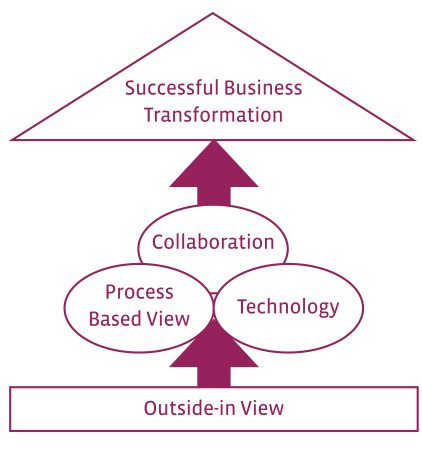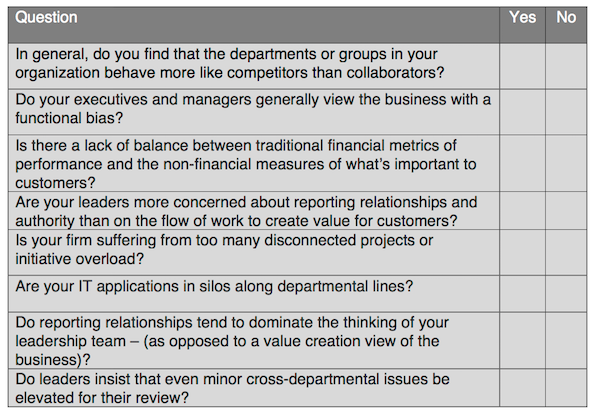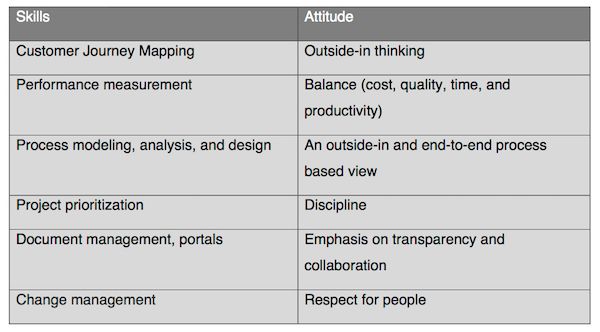 Guest Post
Guest Post
Introduction
The combined impact of global competition and persistently rising customer expectations is motivating companies to plan and execute transformational change. Incremental improvement, while still necessary, is simply insufficient in the current economic climate. Focusing on customer experience is increasingly becoming recognized as “table stakes” for successful business transformation and firms are beginning to see the value of viewing the business from the “outside-in” or the customers point of view. While digital transformation has the potential to reshape the way business is done, cross departmental collaboration is equally essential for customer value creation as attempting business transformation in the context of a traditional view of business is progressively becoming more difficult. People from different functional areas need to work together to create value for customers – and the role of cross functional teams is assuming growing importance as the pace of change accelerates. Adaptability and the effective deployment of remote workers is becoming the norm – as work becomes more and more project based— via collaboration in teams.
Often companies talk about transformation when they redesign a minor element of their business. However, let’s understand that if the company does not place a significant emphasis on creating more value for customers – it’s really not business transformation. Nor is it truly transformational if the initiative is just the application of new technology to produce a minor change to the current business model or if the effort is only focused on cost reduction.
As Figure 1 below illustrates, business transformation is best built on a solid foundation of viewing the business from the “outside-in” and then the combination of a process based view and enabling information technology is central to creating value. Collaboration is the glue that needed for success with business transformation. The key point is this: Successful business transformation accomplishes several objectives simultaneously. It drives major change at the enterprise level, creates more value for customers, potentially challenges the current business model and creates value through a collaborative process perspective and the deployment of information technology.

Figure 1. Collaboration is key for successful business transformation.
Viewing the Business from the Outside-In
A relentless focus on customer experience has become the so called “sine qua non” – or an essential condition for successful business transformation. The perspective of viewing the business from the outside-in, i.e. from the customer’s point of view, shifts the focus from a traditional view to more of a customer centric view – and that enables business transformation. Given that it costs much more to acquire a new customer than to retain an existing one, this “outside-in” perspective is instrumental to improving customer retention. Companies now realize that while modeling selected customer touchpoints is a good start – as it represents a snapshot of customer experience – the bigger and more dynamic perspective is that of the customer’s end-to-end journey. A customer journey map is NOT built from the company’s perspective – nor is it about your organization’s internal business processes or procedures. Instead, a customer journey map has to be built from an “outside-in” perspective – using the terms and expressions a customer would use. When well done this map sets the organization up for success in radically changing its business practices in two key areas: performance measurement and process redesign.
Customers care mostly about value for money and the timeliness and quality of services they receive – and that is something many organizations simply do not measure well. The minimum acceptable set of customer facing metrics typically include perfect order delivery, variance to promise, and first time right responses to inquiries. Focus on the customer’s total experience, delivering personalized service and providing customers with more self-service options are other important components of becoming easy to do business with. The focus on customer experience is quite different from Customer Relationship Management (CRM) which is typically developed only from the organization’s point of view and examines key touch points with customers with the primary intent of capturing customer information for revenue generation. A focus on CRM is not enough in today’s business environment for customer value creation and certainly not for business transformation.
Tearing Down Silos
As organizations invest more energy in understanding customer experience, leaders realize the negative impact of departmental silos on business performance. Indeed, departmental silo behaviour is arguably the largest obstacle to success with both customer experience improvement and business transformation. Silos, fiefdoms, turf, smokestacks! You pick your favourite term, but whatever the word, “silos” represent the management phenomenon where individual departments or regions are acting in their own self-interest, and thereby sub-optimize organizational performance. Powerful departmental, functional, product line and even geographic silos can frustrate even the most well thought efforts to improve business performance for customers. Generally speaking, the larger the organization, the more likely one observes the emergence of management silos and misalignment. Silos impede customer focus, innovation, the effective allocation of resources, and continuous improvement. Yet far too many organizations lack a blueprint for breaking down these silos – and yet this is especially essential when an organization is intent on business transformation. Do you have a problem with organizational silos? The self-assessment below may give you some insight on the extent of silo behavior in your own company.
 If your answer was a resounding “yes” to two or more of the above questions – you may be facing significant challenges. As each group or department is focused on its own primary objectives, silos encourage behaviors that are beneficial to the participants of the group in question, but are not in the best interests of the organization. Silos typically evolve due to cultural, linguistic, and information system factors. Silos stifle both cross group communication and collaboration and this impedes major change. That’s why silo behavior is so dangerous. The essence of silo busting is to be found in companywide goal alignment with a focus on customer experience, cross-functional process improvement and cross-group, cross-regional collaboration. Viewing the business from the “outside-in” can become a powerful catalyst simply because this outside-in perspective allows various stakeholders to view the end-to-end flow of work in the correct context.
If your answer was a resounding “yes” to two or more of the above questions – you may be facing significant challenges. As each group or department is focused on its own primary objectives, silos encourage behaviors that are beneficial to the participants of the group in question, but are not in the best interests of the organization. Silos typically evolve due to cultural, linguistic, and information system factors. Silos stifle both cross group communication and collaboration and this impedes major change. That’s why silo behavior is so dangerous. The essence of silo busting is to be found in companywide goal alignment with a focus on customer experience, cross-functional process improvement and cross-group, cross-regional collaboration. Viewing the business from the “outside-in” can become a powerful catalyst simply because this outside-in perspective allows various stakeholders to view the end-to-end flow of work in the correct context.
Redesign End-to-End Processes
True value for customers is created via the flow of work that crosses departmental boundaries. Yet, many organizations are managed principally according to a traditional view where plans, budgets, and even rewards are developed in a departmental context. This mindset leads organizations to focus on small processes within departmental boundaries (simply because it is easier) – and that is insufficient for successful transformation. A focus on the significant end-to-end business processes is needed for business transformation, as this emphasizes value creation and also contributes to tearing down departmental silos.
In 2003, I described business process management (BPM) as a deliberate, collaborative, and increasingly technology-aided focus on the definition, improvement and management of a firm's end-to-end enterprise business processes. Not just the definition or modeling of a business process. Not just process improvement. Not just the monitoring or management of business processes. But all three of these, in parallel and on a continuing basis.
The end-to-end process view will yield benefits in terms of performance measurement too. Estimating current process performance requires a balance between the traditional metrics such as volume and cost and other metrics that matter more to customers such as quality and timeliness. Since no one department – by itself – can determine the level of process performance – BPM is a "team sport", as people from different functional areas work together to create value for customers. Further, when success is realized in compressing process cycle time, then the cost of operations is automatically reduced. And those cost reductions can be amplified when the process context pinpoints prime areas to apply new information technology tools such as robotic process automation (RPA) for rapid results. When BPM is deployed according to a customer centric view and integrated with technology, it can fuel business transformation.
Technology
Enabling information technology is needed for significant success with process redesign. New technology is now making it easier for managers to work together on platforms for collaborative process design. Modern workflow tools, business rules management, document management, portals and other UI, performance management dashboards, and simulation all have a role in successful business transformation. Business process models reveal the way in which work is done and form the basis for candid discussion, introspection, and innovation.
Social, mobile, analytics, and cloud technologies (sometimes referred to as “SMAC”) are used more and more to improve business performance. Evolving technologies such as artificial intelligence (AI), cognitive computing, and robotic process automation (RPA) have significant potential to make even greater contributions to a process based view of performance. RPA offers the potential to harvest low hanging fruit as it is relatively quick and inexpensive to deploy and simply automates what humans do. This means that in the majority of cases, negligible process redesign is involved. For example, if a financial advisor needs to log into three different systems to onboard a customer then the RPA software robot (or “bot”) will do the same thing – except much faster, cheaper and with fewer errors. Even greater benefits may be realized when RPA becomes integrated with BPM.
How do you know when you are making progress in implementing enabling technologies? Answering these five questions could provide you with insight on your progress:
1. People begin to talk as much about creating value for customers through IT enablers as they do about applications.
2. IT people talk increasingly in business terms about customer retention and loyalty.
3.There is a stronger alignment between business priorities and the IT project list.
4. Greater data visibility and transparency due to enabling IT systems is celebrated.
5. The IT-business divide is no longer a topic of conversation.
The role of technology also enables cross departmental collaboration as people from different functional areas work together with new tools to create value for customers. In this context, successful organizations will find that adaptability and the role of remote workers will gradually become the norm — with new tools and greater transparency enabling collaboration in cross functional teams.
Collaboration: Successful Business Transformation is a Team Sport
Cross functional collaboration is the glue that holds together the focus on customer experience, the process based view and the effective use of enabling technology in facilitating business transformation. If there is not a clear focus on making it easier for employees to serve customers, then it's not business transformation. Work is no longer just a place where people go on a daily basis – it can take place anytime, anywhere. Certainly there is no lack of available social media collaboration technologies including Facebook, LinkedIn and other social platforms such as Instagram, Chatter, Yammer and Jive, and even tools such as AnswerHub and Spigit. But there’s much more to collaboration than just these tools.
While email remain a principal form of communication, the ability to improve transparency and visibility via document management, the use of portals and other forms of user interface (UI) is becoming recognized as essential. It’s important to deeply embed the means of collaboration into end to end business processes. Rather than just automating the old ways of doing things, the thoughtful deployment of collaboration tools will make it possible to do things in new and exciting ways. Simply making collaboration tools available is not enough. Engaging in change management activities that promote desired collaborative behaviors is equally significant. Executives can expect more from encouraging collaboration when they consciously introduce incentives to collaborate.
Mindset Matters
A shift in management mindset is arguably the single most important component of successful business transformation. While many managers understand the compelling logic that both customer and shareholder value is created by means of end-to-end business processes, a surprising number of companies continue to cling to a traditional, functional view of the business. When leaders begin to spend as much mental and emotional energy on delivering value to customers as they do on examining actual to budget comparisons – then fundamental and even transformational change may begin. Shifting management mindset is a matter of both attitude and aptitude as depicted in the table below.
Successful business transformation is based on an outside-in view. It has the potential to challenge the current business model and create value through an end-to-end process perspective and enabling technology. It drives major change at the enterprise level in order to create more value for customers and shareholders alike. Successfully executing business transformation is best accomplished through collaboration and an integrated approach to process and technology such that it becomes easier for employees to delight customers. About the Author
About the Author

Andrew Spanyi is the founder and Managing Director of Spanyi International Inc. His thought leadership on process management is based on over two decades of practical experience assisting organizations with large scale change. He has written 3 books stressing the importance of collaboration in process management and he has contributed chapters to several other publications on related topics. He is also on the board of advisors for the Association of BPM Professionals and is the Editorial Director with BPMInstitute.org.
Contact: andrew@spanyi.com  Interested in learning more about why collaboration is the key to successful transformation and how you can increase collaboration within your organization? Check out this special webinar event with Andrew on Tuesday, September 19, offered through Signavio.
Interested in learning more about why collaboration is the key to successful transformation and how you can increase collaboration within your organization? Check out this special webinar event with Andrew on Tuesday, September 19, offered through Signavio.



